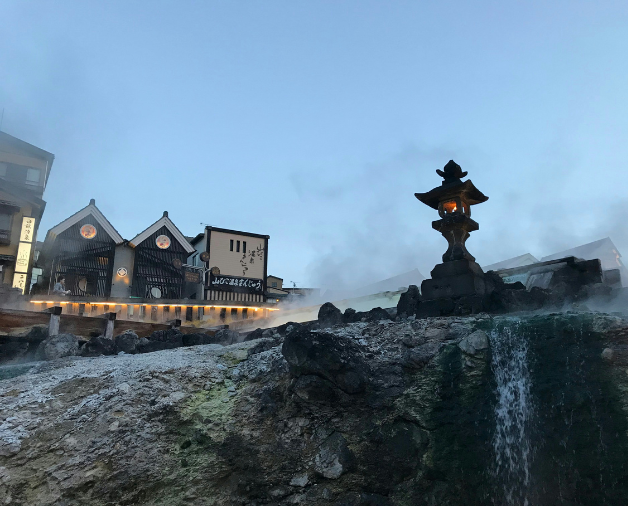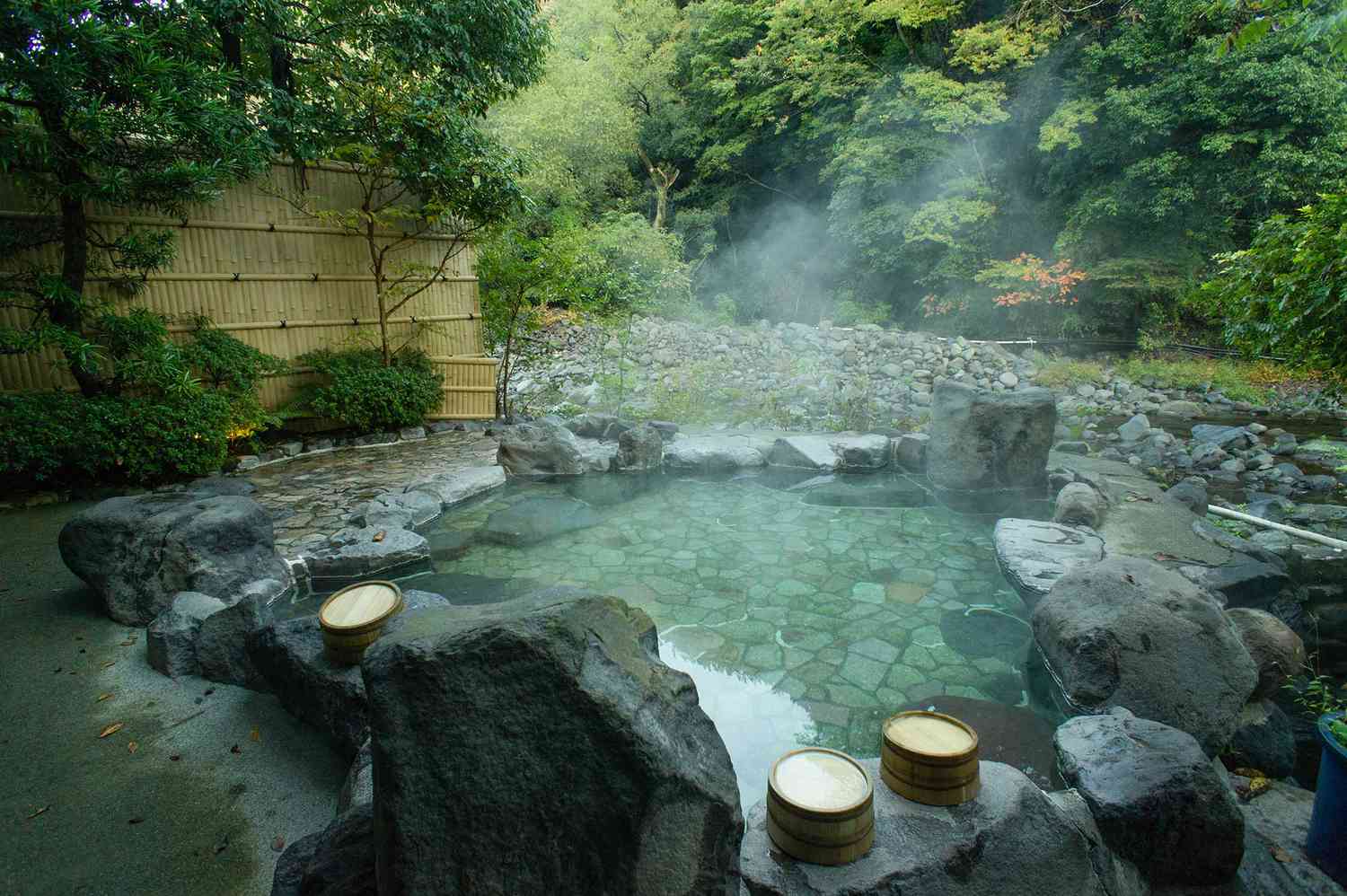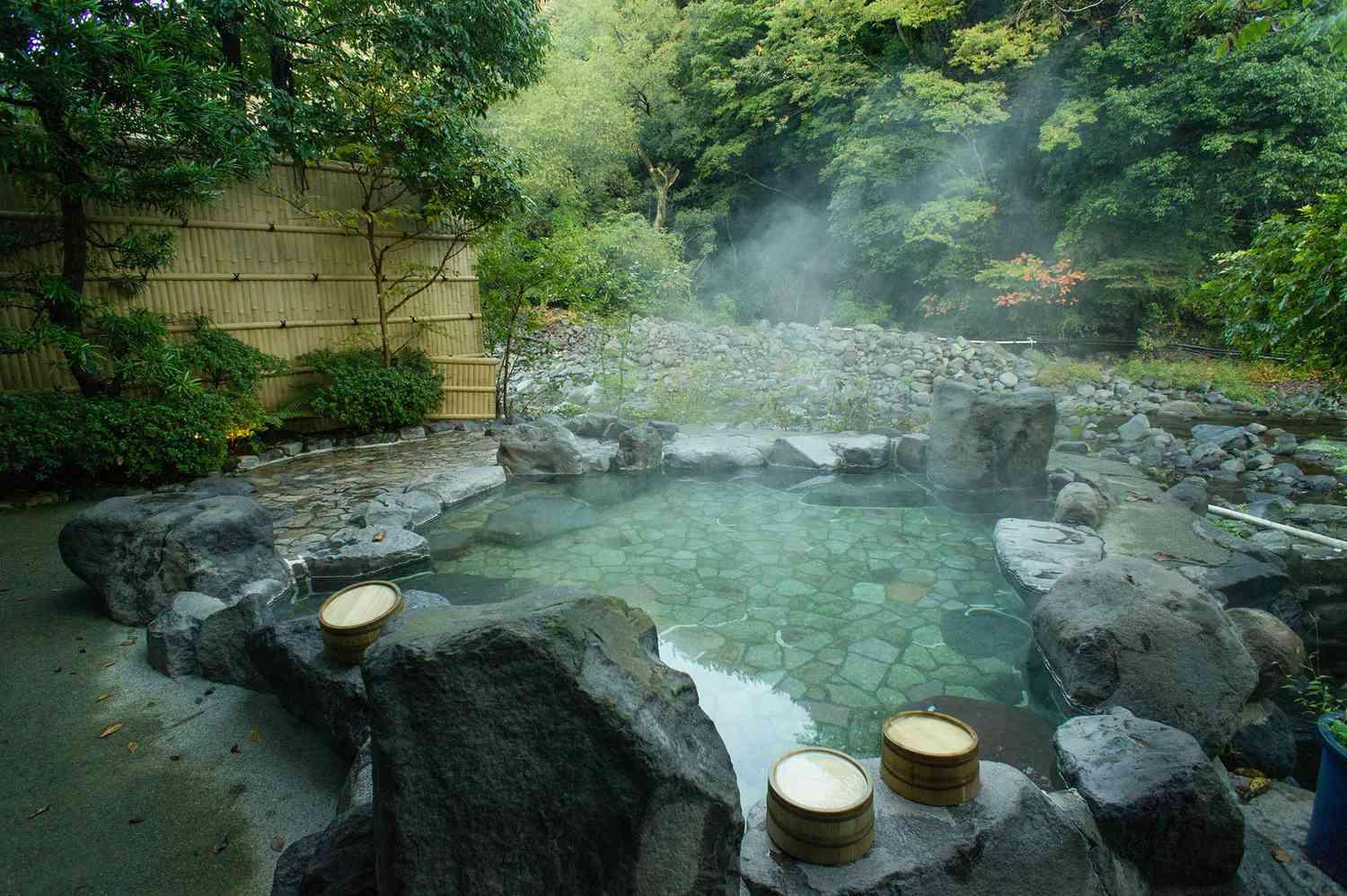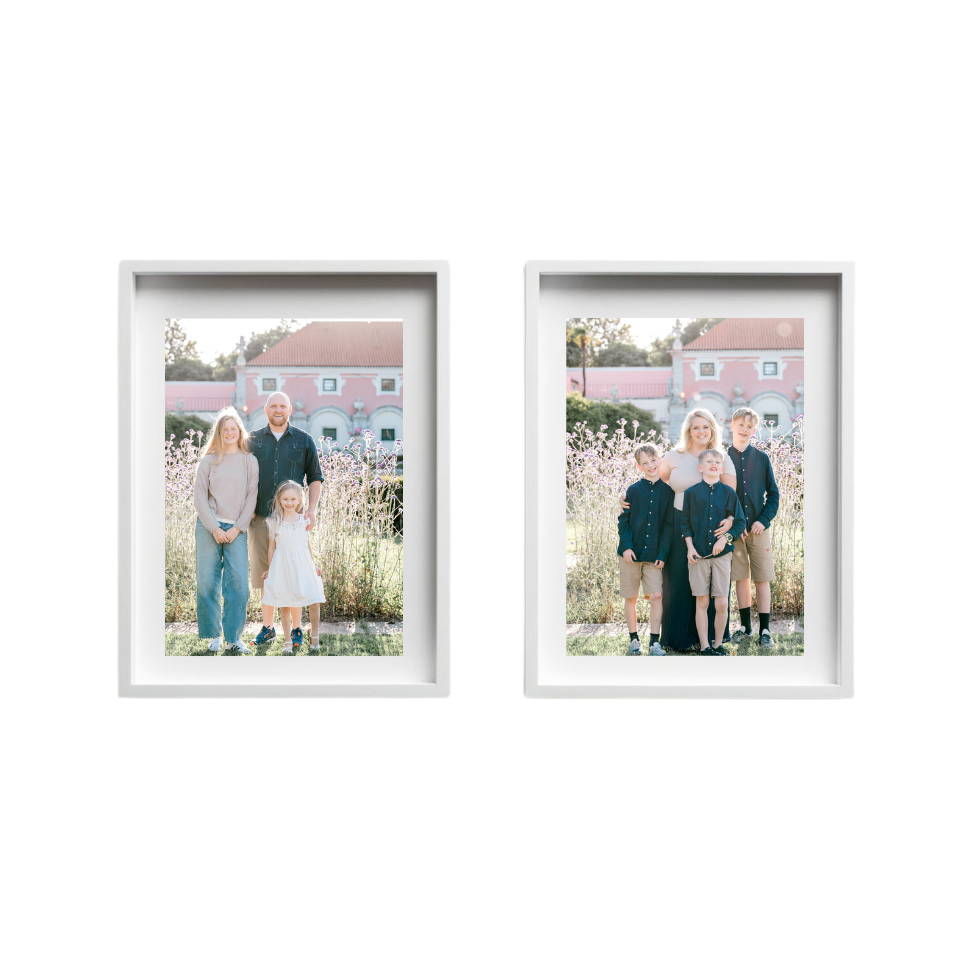

One of the most magical, uniquely Japanese experiences you can have is soaking in an onsen, natural hot springs that range from rustic and wild to luxurious and spa-like. A lot of us Westerners have some reservations about this, as you are, in fact, naked in the onsen! However, this is a super important part of Japanese culture and doesn’t need to be limited to just adults. Onsens in Japan are a sort of leveling ground… a boss and employee may have a work relationship on the street, but inside the onsen, they can be equals and friends.
What happens when you’re traveling with kids in tow? Is it even possible to enjoy this traditional Japanese ritual as a family?
As a mom of five who loves traveling with my crew (yes, even the tiny ones with the wiggles! We’ve been seriously traveling for over seven years), I’m here to tell you: yes, you can absolutely visit onsens in Japan with kids, and have an amazing, memory-making time doing it. Let’s discuss what should be on your radar before you take on this experience in Japan.
In Japan, “onsen” refers to natural hot springs, and the bathhouses or ryokan (Japanese inns) built around them. These baths are steeped, literally and figuratively, in tradition. They’re also seen as a way to relax, heal, and rejuvenate both body and mind.
Onsens can be found in every neighborhood, most hotels, and some stand-alone options. They range from the super simple, like the neighborhood rec center, to the fancy ones with restaurants inside!
Here’s the catch: onsens have some etiquette that can feel intimidating at first, especially when you add kids to the mix.
What should you bring to an Onsen? What do you wear? All of these questions can feel like a lot to tackle.

Short answer: usually, yes! Long answer: it depends on the onsen.
Most places in Japan are quite kid-friendly, and many onsens welcome children. Babies and toddlers are generally not allowed, especially if they are in a swim diaper.
Some higher-end or very traditional onsens may have age restrictions, especially in gender-separated baths. Most onsens are separated by gender, and you’ll see these naked Japanese talking and laughing with each other just like they do outside! Maybe even more.
Always check ahead of time or ask when booking on what the age restrictions are for kids and if kids are allowed. However, don’t get discouraged by a couple of “no” s. Onsens can be family-friendly!
Here’s how a typical onsen visit goes and how to make it work for the little ones:
Most public baths are separated by gender. This means one parent will likely take all the kids of the same gender. Some onsens do offer family baths (kazoku buro), which are private rooms you can book to soak as a family—these are gold for traveling families.
Yes, you’re completely nude in the bath area (bathing suits not allowed!). This can be a bit awkward for foreigners, but I promise it’s very normal in Japan, and no one bats an eye. I was nervous the first time, but I quickly got over it once I saw everyone else casually relaxing. I was the awkward American with a little towel trying to cover my private parts. Try to overcome this! This is such an important part of the culture that I promise you are drawing more attention to yourself by being shy than by just owning it.
Thankfully, kids are generally good at owning this! Teenagers… different story! However, I like to expose my kids to cultures where it’s not weird to be seen naked. We’ve done thermal baths in Iceland, in Budapest, and more, and in general, Americans are the weird ones!
Before entering the bath, everyone washes thoroughly at the shower stations. Teach your kiddos this essential step; it’s part of the ritual and shows respect for others.
While living in Europe, this has become a lot more normal to me. Now I think it’s a bit weird we don’t do this more in the US! It makes a lot of logical sense!
Once squeaky clean, it’s time to enjoy the hot mineral water! Most kids love the warm water (just be cautious if it’s very hot), and some onsens have cooler pools or even outdoor areas where the experience feels more like a relaxing adventure.
You can stay as long as you want in this lovely water (as your schedule permits), but kids are going to get bored pretty quickly. Relaxing with kids is always a relative term 🙂

Not all onsens are created equal when it comes to traveling with kids. After researching, reading through fellow family travel blogs, and soaking in a few ourselves (pun intended), here are some standout onsens that make families feel truly welcome.
Pro tip: There’s a free shuttle from Hakone-Yumoto Station, which makes access a breeze even with tired legs or sleepy toddlers.
Heads up: This spot closed temporarily in 2023 but is expected to reopen soon as part of a new entertainment complex near Tokyo Bay.
Tip: Combine your visit with a hike through the Kurama-dera Temple trail for an unforgettable day in the Kyoto countryside..
Bonus: If you’re lucky with the weather, the view from the open-air bath is postcard-worthy—Mount Fuji rising majestically above the steam.

When traveling with kids, planning ahead can make or break your day, especially when visiting somewhere as serene and structured as an onsen. Here’s what you need to know to keep things smooth and stress-free.
Prices vary depending on the region, type of onsen (public bath vs. ryokan resort), and whether you book a private bath. Here’s a general breakdown:
| Type of Onsen | Adults | Children | Notes |
| Public Onsen (local bathhouses) | ¥400–¥1,000 ($3–$7 USD) | ¥200–¥500 ($1.50–$4 USD) | Affordable and common; often very local/traditional. |
| Onsen Resorts (with amenities) | ¥1,200–¥2,500 ($9–$18 USD) | ¥600–¥1,200 ($4–$9 USD) | Includes yukata rental, lounge access, sometimes food options. |
| Private Family Bath (Kazoku Buro) | ¥2,000–¥5,000 ($15–$38 USD) per hour | Flat rate for group | Reserve in advance! Many are time-limited (30–60 minutes). |
| Ryokan Stay with Onsen Access | ¥10,000–¥30,000+ per adult ($75–$225 USD) | Reduced rate for kids | Includes overnight stay, meals, and unlimited onsen access. |
Tip: Many ryokan offer free onsen access included with your stay, and some even allow booking private baths at no extra charge—always ask!
If you’re traveling during Japanese national holidays like Golden Week (late April–early May), Obon (mid-August), or New Year’s, expect bigger crowds and higher prices. Try to book anything private in advance.
Onsens are known for their simplicity and calm, and luckily, most of them provide the essentials, so you don’t have to overpack. Still, when you’re visiting with kids, a little preparation goes a long way, especially when it comes to comfort after a hot soak or avoiding a last-minute meltdown because someone forgot a hair tie.
Whether you’re headed to a traditional onsen town or a modern city spa, here’s a breakdown of what you should bring, what’s usually provided, and a few extras that can make your family visit smoother.
Fun parenting tip: The tiny onsen towel tradition is a great one to share with your kids. Let them try balancing it on their heads like the locals do, it’s half bath time, half cultural moment!
| Bring It Yourself | Provided (Usually) | Optional Extras |
| Small towel (for washing) | Body soap & shampoo | Large towel for drying (can rent or bring your own) |
| Large bath towel | Hairdryers | Yukata (usually with ryokan stays or day spas) |
| Toiletries | Hair ties/combs | Drinks/snacks at vending machines or café |
| Swim diapers if required | Coin lockers | Extra clothes for kids after a hot soak |
Important note: The small towel is not to be brought into the bath itself! Set it on your head or the side of the tub—this is a fun detail to teach the kids (and they love trying it!).

If you’re feeling a little nervous about the whole “public bathing with kids” part of visiting an onsen, don’t worry, you’re not alone. One of the easiest and most stress-free ways to dip your toes (literally!) into the onsen experience as a family is by booking a private bath, also known as a kashikiri onsen.
These are perfect for families with shy kiddos, toddlers who like to splash, or just parents who want to relax without worrying about onsen etiquette mishaps. You’ll have your own space, no strangers, and usually some sweet perks to go with it. Here’s how it works:
Look for terms like:
There’s something about soaking in a hot spring while surrounded by snowflakes, steam rising in the cold air, that feels like a scene from a dream. And sharing that with your kids? It’s unforgettable. Beyond the physical relaxation, it’s a chance to experience an essential part of Japanese culture together. I love seeing all my friends chatting away for hours! My husband and I were even approached for conversation, but we both were a little too shy for this. However, it’s amazing to see this normally reserved culture come to life in the onsens.
Plus, after a long day of hiking Mt. Fuji, visiting Osaka, or navigating Tokyo’s train stations, you all deserve a good soak.
—-

Check out your travel necessities from a comprehensive list of all the 7Wayfinders Travel Must-Haves. Click Here!
Find a nice hotel near Japan from Expedia, or Vrbo, (we also love Tripadvisor and Hotels.com)
Discover more of Japan while having fun through exciting activities from GetYourGuide, Airbnb Experiences, or Viator
Need to rent a car to navigate the city? Visit Rentalcars.com.
Get insured while traveling with World Nomads / SafetyWing
Want to have a photo shoot while traveling? Check out flytographer!
Capture your best memories in Osaka as we do with a GoPro, Sony camera, or our favorite drones: DJI FPV, Air, and Mini
Check out your travel necessities from a comprehensive list of all the 7Wayfinders Travel Must-Haves. Click Here!
Exploring Osaka, Japan, With Kids: Top Tips for Family Visits
Tips for Hiking Mount Fuji in Japan for Normal People
How to Choose the Best Travel Insurance for Your Family
How to Avoid Scams Traveling in Asia
Experiencing Carnival in Portugal: Your Ultimate 2025 Guide
